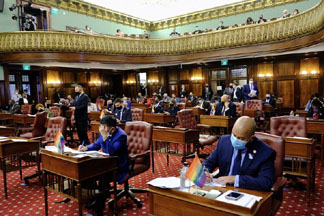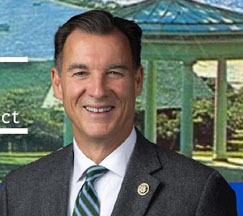
- Council modifications address affordability and neighborhood differences; agreement will invest $5 billion in City for All housing plan
- Council also voted on bills to establish basement apartments and ADUs in city codes, support building rehabilitation, track approved housing projects, and update flood maps and sewer plans
CITY HALL, NY (TIP): The New York City Council, on December 5, passed a historic citywide zoning reform that is estimated to create over 82,000 new homes throughout the five boroughs. Together with an agreement to invest $5 billion in the Council’s City for All housing plan to support affordable housing, homeownership, and neighborhood infrastructure improvements, the Council-modified zoning changes represent one of the most significant advancements of housing solutions in New York City history. It is another major step by the Council to address the city’s housing and affordability crisis, building on Speaker Adrienne Adams’ Fair Housing Framework Act and the recently passed FARE Act to reform broker fees.
The Council also passed legislation to provide complementary legal frameworks to the zoning reforms for ADUs and basement apartments, as well as to better track approved affordable housing developments, provide tax abatements for the maintenance and preservation of affordable housing buildings, update flood maps and sewer maintenance plans, and support older adults aging in place.
“Today, the Council made historic strides to create more homes and make our city more affordable by approving the modified Zoning for Housing Opportunity text amendment with $5 billion of major investments in our City for All housing plan,” said Speaker Adrienne Adams. “By taking a major step to address the housing shortage, while supporting existing homeowners and tenants, making housing more affordable, expanding homeownership opportunities, and strengthening the infrastructure of neighborhoods, we are advancing a safer and stronger city. This shows that our city can ensure every area helps contribute to confronting the housing crisis by creating more housing, while respecting the differences of neighborhoods across the five boroughs and investing in New Yorkers.”
Building More Homes, Investing in Affordability and Neighborhoods
City of Yes: Zoning for Housing Opportunity – A citywide zoning text amendment, initiated by the Department of City Planning and modified by the Council, to change residential height, density, parking requirements, affordability, urban design, and other aspects within city zoning regulations. It is the first citywide zoning text amendment designed to increase housing production across all neighborhoods and is estimated to create over 82,000 housing units over 15 years.
In response to robust community engagement, the Council modified the proposal in three primary ways: to make new housing development more contextual with existing neighborhoods, particularly for blocks of small homes; to increase the amount of affordable housing that will be created and make sure it reaches New Yorkers with lower incomes; and to protect existing tenants and homeowners.
Council modifications precisely tailored certain proposals to reflect a neighborhoods’ public transit, flood risks, and existing homes, while preserving all key elements in the initial text amendment and the core fair housing principle that every neighborhood contribute to housing production. A key modification by the Council includes establishing affordable housing incentives in low-density areas that make inclusionary zoning citywide for the first time in New York City, ensuring the creation of affordable housing is possible in every part of the city. The Council also advanced modifications to establish greater affordable housing levels for existing and new zoning incentive programs, so they reach New Yorkers with incomes at or below 40% of area median income (approximately $43,000 for an individual and $62,000 for a family of four).
The modifications are detailed here.
In addition to the zoning changes, the Council secured $5 billion in City and State funding commitments for its City for All housing plan. The funding will support affordable housing, NYCHA, Mitchel-Lamas, affordable homeownership, sewer, street and open space infrastructure improvements, tenant protections, city housing agencies, and new neighborhood planning efforts to create more housing in future years.
Establishing Basement and Ancillary Dwelling Unit Legalization
Introduction 1127-A, sponsored by Council Member Pierina Ana Sanchez, would establish a basement and cellar dwelling unit legalization program in certain community districts. The Department of Buildings would inspect such units prior to issuing an authorization and, if issued, the building owner would be permitted to do any necessary construction on the unit to legalize the unit and apply for an amended or partial certificate of occupancy. The Department of Housing Preservation and Development would be required to provide technical assistance and outreach to owners of eligible basement or cellar residences.
Introduction 1128-A, sponsored by Council Member Pierina Ana Sanchez, would set forth eligibility and design requirements for ancillary dwelling units (ADUs) in one- or two-family dwellings, including utility systems and fire prevention requirements. This bill would prohibit basement and cellar ADUs in coastal and inland flood hazard areas, to mirror such prohibitions in the New York City Zoning Resolution. In localities where ADUs are legalized, homeowners have used them in variety of ways including supplementing their income, downsizing while renting out the primary residence, and sustaining multigenerational living.
“New Yorkers already live in ancillary dwelling units, including basement apartments and garages, and they deserve safe and dignified housing. Alongside zoning changes that the Council is voting on today, Intros. 1127 and 1128 will provide the necessary building code updates to ensure ADUs are safe for existing and future residents. Regulating these units addresses a range of potential risks including fires, carbon monoxide poisoning, and with the growing consequences of climate change, flooding. These bills will bring existing and future ADUs up to code by assuring they have proper heating, ventilation, electrical, gas, and emergency service systems,” said Council Member Pierina Sanchez. “Together with the modified ADU proposal in City of Yes for Housing Opportunity, and financial support for homeowners who wish to add an ADU in the Council’s City for All plan, these bills mark a crucial step toward preserving and creating safe, affordable housing options throughout New York City.”
Renewing the J-51 Tax Abatement Program
Introduction 654-A, sponsored by Council Member Pierina Ana Sanchez, would implement a renewed version of the J-51 program for rehabilitation and renovation projects of certain multiple dwelling buildings. Following the expiration of J-51 in June 2022, the State Legislature passed, and the Governor signed, legislation authorizing the City to enact a new, altered version of the J-51 program. Eligible buildings would include: condos and coops where the average assessed valuation is under $45,000 per unit, and rental buildings where more than half the units are affordable, they are operated by limited-profit housing companies, or they receive substantial governmental assistance. Owners of these buildings could recover up to 70% of the cost of work to rehabilitate these buildings in the form of tax abatements for up to 20 years. The Department of Housing Preservation and Development would establish a certified reasonable cost schedule to identify the work and costs that qualify for this program and will report annually on its implementation and enforcement.
“New Yorkers are leaving the city in record numbers, and those who stay are left to face the intersecting crises of housing unaffordability, evictions, and homelessness. For our low- and middle-income neighbors, we must do everything we can to preserve and upgrade their homes for the next generation,” said Council Member Pierina Sanchez. “I am proud to have championed Int. 654, which re-establishes the J-51 tax benefit—a critical preservation tool that offsets improvement costs for low-to-moderate cost residential buildings. This iteration of J-51 includes important reforms: added tenant protections, prioritization of energy efficiency work to meet our city’s climate goals, and data transparency to understand the full reach of the program. This bill will save 166,000 families in co-ops across the city thousands of dollars each year, while enabling buildings across the city to comply with the ambitious and necessary climate goals of Local Law 97. Local Law 97 is the nation’s most aggressive municipal climate law, targeting emissions reduction that can make our communities easier to live and breathe in. With Int. 654, we can upgrade our housing, put money back into the pockets of everyday New Yorkers, and green our city.”
Improving Transparency of Affordable Housing Project Status
Introduction 850, sponsored by Council Member Rafael Salamanca, would require the Department of Housing Preservation and Development to submit biannual reports to the Council regarding city-financed affordable housing development projects involving the disposition of city property. The reports would include the date the developer was selected by HPD, the date the project received ULURP approval, the 6-month cycle during which the disposition is expected to occur, and the actual closing date for projects that have already closed.
“As the Chair of the Committee on Land Use for the last seven years, I have had the privilege of overseeing the approval of well over 100,000 units of new housing across New York City,’ said Council Member Rafael Salamanca. “In my district alone, I’ve approved over 10,000 units of 100% affordable housing. Unfortunately, there is a sad reality. Despite the lengthy negotiations it takes to approve a project and the critical need within our communities for new housing, the City’s Department of Housing Preservation and Development (HPD) often takes *years* to provide the necessary project funding to facilitate a development’s groundbreaking, delaying much-needed housing in the process. This lack of transparency is why I introduced Intro 850, which would require HPD to report biannually when projects can expect to receive financing as part of the agency’s twice-a-year closing period. If a project does not close within a targeted closing cycle, HPD would be required to report the reasoning, and when a new closing date can be expected. Mandating this information to be public is an important step in understanding how the city truly prioritizes the development of housing across New York City. I thank Speaker Adams for her leadership on this issue, and look forward to the full support of all my colleagues.”
Updating Flood Maps and Sewage Flooding Plans
Introduction 814-A, sponsored by Council Member James Gennaro, would require that the Department of Environmental Protection (DEP) update the sewer backup prevention plan by 2025 and conduct regular updates thereafter. DEP regularly conducts field investigations in response to complaints of sewer backups, but the outcome of those investigations is not always shared. Therefore, the bill would also require DEP to provide timely notice to residents and complainants when it determines that certain sewer backups have occurred.
Introduction 815-A, sponsored by Council Member James Gennaro, Introduction 815-A, sponsored by Council Member James Gennaro, would require DEP, in consultation with DOB and the Office of Long-Term Planning and Sustainability, to create and regularly update an interim flood risk map identifying areas at risk of flooding due to 10-year rainfall events and sea level rise (as projected for the year 2050), as well as coastal flood areas with a 1% or greater chance of flooding in any given year (including the impacts of sea level rise as projected for the year 2080).
“I am proud to introduce Intro 0814 and Intro 0815 – two potentially lifesaving bills that will provide a comprehensive framework for building a safer and more resilient New York City,” said Council Member James Gennaro. “Intro 814 requires the Department of Environmental Protection update its plan to prevent sewer backups at least once every 5 years and alert residents when it determines that a sewer backup may have been caused by an issue in a privately-owned sewer. This bill will reduce the frequency of sewer backups, saving New Yorkers from costly damage to their homes and exposure to raw sewage. Intro 815 creates a special designation for ‘inland flood hazard areas’ – a measure that is long overdue. This bill provides the tools and data we need to protect New Yorkers in areas outside traditional flood zones. By mapping inland flood hazards, we enable smarter planning and more effective emergency responses. Introduction 815 also creates a coastal flood risk map that, unlike FEMA flood maps, anticipates the impact of sea level rise. As extreme weather becomes more frequent, we must increase our city’s resilience to flooding from coastal storm surge and rainfall. Intro 815 helps to achieve that goal.”
Supporting Older Adults with Aging in Place
Introduction 1022-A, sponsored by Council Members Jennifer Gutiérrez and Crystal Hudson, would require the Commissioner of the Department for the Aging to conduct a three-year study on Naturally Occurring Retirement Communities (NORCs) and Neighborhood Naturally Occurring Retirement Communities (N-NORCs) in New York City. The study would identify potential NORCs and N-NORCs, assess the needs of older adults, evaluate necessary improvements, and collect data on demographic trends and health outcomes. Within two years of completing the study, the Commissioner would be required to develop and implement a plan to support aging in place within these communities.
“Today, we take a vital step to ensure older New Yorkers can age in place with dignity and support,” said Council Member Jennifer Gutiérrez. “The Expanding NORCs Act addresses the needs of our aging neighbors by expanding beyond the current 37 NORCs, which serve only a fraction of the 1.5 million older adults in our city. By removing barriers tied to nonprofit infrastructure, and ensuring that the City is doing comprehensive studies and planning – this legislation will help identify and support at least 20 new NORC communities and thousands of older adults. I’m grateful for Chair Hudson’s leadership and partnership in making this possible.”
Introduction 1054-A, sponsored by Council Member Crystal Hudson, would require the Commissioner of the Department for the Aging to submit a 10-year Aging in Place Plan that would focus on assisting older adults with aging in place throughout New York City, and would include proposed projects and recommendations.
“Today, we take an important step forward in ensuring that older New Yorkers can age in place with the support and resources they need,” said Council Member Crystal Hudson. “The passage of Int. 1054, a key component of our Age in Place 2.0 initiative, mandates a comprehensive 10-year plan that will guide how we support our growing aging population across the city, particularly in naturally occurring retirement communities. With a 40% increase in our older adult population by 2040, requiring regular progress reports and updates from the Commissioner of NYC Aging will ensure that we are not only setting ambitious goals, but also holding the city accountable for delivering on them. We are making certain that New York City remains a place where older adults can live with dignity, independence, and security for years to come. After all, older adults are the future.”
Finance
A preconsidered resolution, sponsored by Council Member Justin Brannan, authorizing a 40-year Article 11 tax exemption for the preservation of one rental building in Council Member Eric Dinowitz’s district.
A preconsidered resolution, sponsored by Council Member Justin Brannan, authorizing a 2.5-year Article 5 tax exemption for the preservation of two rental buildings in Council Member Yusef Salaam’s district.
A preconsidered resolution, sponsored by Council Member Justin Brannan, authorizing a 40-year Article 11 tax exemption for the preservation of two rental buildings also in Council Member Yusef Salaam’s district. And a transparency resolution approving new designations and changes of certain organizations receiving funding in the Expense Budget.





Be the first to comment